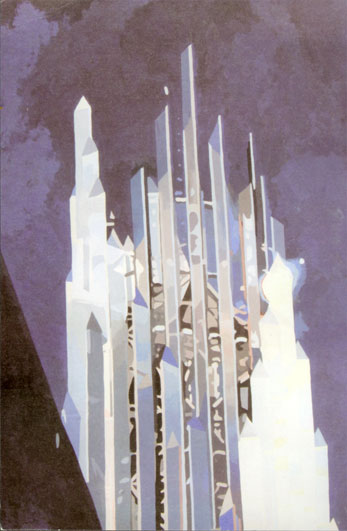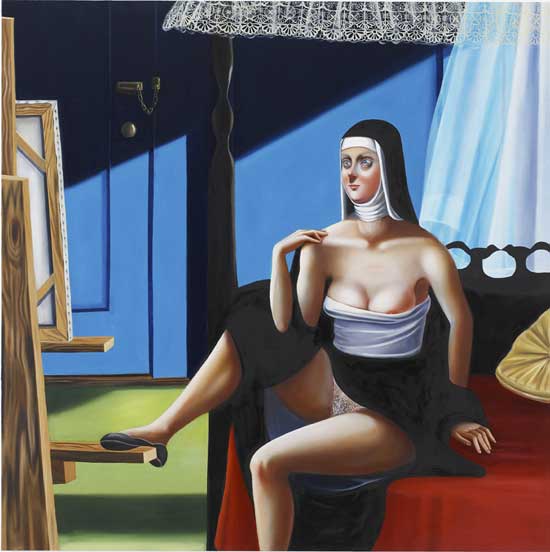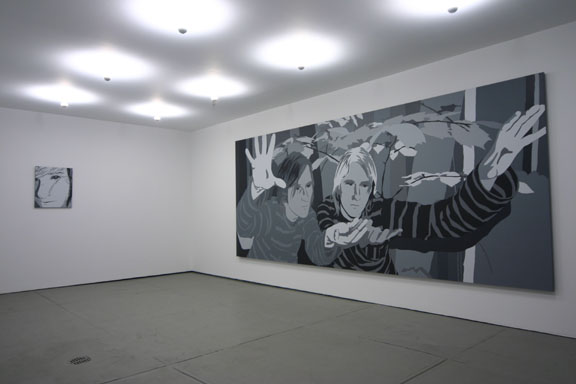I was really looking forward to my trip into Chelsea this past Thursday. I'll admit it: I fell in love with Lisa and Sara Jo at Schroeder Romero. They charmed me, plain and simple. So I was looking forward to seeing them and what they had to show me with their new exhibition.
Before moving on, let me admit to a bias: I don't generally like people who use text in visual art. To me, putting text into a painting is like farting during a symphony. If you want to play with words, become a writer. I'm not saying that it's impossible for visual art to use text well; I'm saying it had better be very compelling for me to like it.
Alas, Eric Heist's "Interfaith Center" is not very compelling. The installation consists of a handful of paintings in gouache at either end of the gallery; in between, on the walls, are "stained glass windows" which appear to be cut out of construction paper; and across the floor are small seats, like minipews, underneath which you can see some junk -- excuse me, I mean "found art." Pinned to each pane of the stained glass is a neatly typed paragraph of text saying something about religion, altogether adding up to several pages of verbiage.
If you want to tackle religion using art, I think you'd better have something extremely good to say, because all of the obvious stuff has already been said. In fact, I'd go so far as to say most of the less obvious stuff, and a fair amount of the obscure stuff, has all been covered extensively and in detail. This show, however, is sophomoric and shallow. The text of the windows -- taken, according to the typed essay at the gallery desk, from various sources, both pro- and anti-religious -- seems mainly calculated to either demolish religion -- including ideas we learned in high school, like how the religions of peace and love have caused more wars than anything else in the world -- or make religious people sound like fools. Maybe there's an element of observer bias, but it seems to me if Eric were attempting to present more than one side of religion, he could have found better quotes.
 As for the paintings, they look as if Eric has taken low-resolution video stills of churches, inside and out, and traced them. They look like paint-by-numbers.
As for the paintings, they look as if Eric has taken low-resolution video stills of churches, inside and out, and traced them. They look like paint-by-numbers.
By far the biggest problem with Eric's installation, though, is how he holds the whole idea of religion at arm's length. There isn't a single feeling in the show; there's no sense that he's dealing with anything personal at all. I got a distinct sense that Eric feels religion is something that happens to other people, that he's on some kind of anthropological expedition. If he'd dug deeply, if he'd really considered what religion means to him, if he'd found some kind of emotion -- love, hate, anger, fear, joy, sadness, fun, boredom, amusement, anything at all -- this might have been a worthwhile subject for his exploration. As it is, the whole thing just sort of sits there. If you're a fast reader you can get everything the exhibit has to offer in about five minutes. Then you can do what I did, which is stand around hoping to have an interesting conversation with someone. And when that fails, you can leave.
You know it's a bad night when the highlight of your evening is discussing beer with a guy named Seamus. Actually, discussing beer with a guy named Seamus isn't a bad night; it's only a letdown if you've been hoping to see some good art. I met Seamus while going through Plus Ultra to say hello to Ed and Murat; Murat continues to be the nicest person I've met in Chelsea yet. Seamus had brought his own Heineken and that prompted our beer talk. If I'd known what was in store for me in the other galleries I'd visit, I would've stayed to debate the finer points of Guinness with my new Irish friend.
 But I did not know what was in store, so presently I found myself at Bellwether Gallery viewing Jocelyn Hobbie's latest paintings. My initial impression, looking at the images on the Web, was that Jocelyn was some kind of cross between Mark Kostabi and Lisa Yuskavage. It looks like she combines cartoonishly sexualized images of women with staid tableaux; breasts are suspended out every which way, parts of females frozen in time in poses of humiliation, or boredom, or tragedy, or something. One of the reviews in the binder at the gallery desk said Jocelyn's work was like "Botticelli meets Katz or Courbet meets Hopper." Although whether the reviewer means Alex Katz, Morris Katz, or the Katz Deli is unclear.
But I did not know what was in store, so presently I found myself at Bellwether Gallery viewing Jocelyn Hobbie's latest paintings. My initial impression, looking at the images on the Web, was that Jocelyn was some kind of cross between Mark Kostabi and Lisa Yuskavage. It looks like she combines cartoonishly sexualized images of women with staid tableaux; breasts are suspended out every which way, parts of females frozen in time in poses of humiliation, or boredom, or tragedy, or something. One of the reviews in the binder at the gallery desk said Jocelyn's work was like "Botticelli meets Katz or Courbet meets Hopper." Although whether the reviewer means Alex Katz, Morris Katz, or the Katz Deli is unclear.
Seeing the work in person I can see that these impressions are dead wrong. What's clear from Jocelyn Hobbie's work, more than anything else, is that she wants very badly to be a classically trained painter. You can't see it very well in the reproductions, but there are places where she paints the veins under the skin, like around a woman's nipples or on the underside of her forearm, or on a forehead. This shows an admirable urge to paint realistic human figures. But it's an urge which is unsupported by Jocelyn's basic skills. What the other painters mentioned earlier in this essay have which Jocelyn lacks is simple draftmanship. Her figures appear stuffed and mounted, not due to any artistic choice, but because she can't draw. Women are cross-eyed and their eyes bloodshot; dress patterns and lace float eerily above the surfaces of which they're supposed to be a part; wood grain is hideously magnified and warped. And all of this, it seems to me, is unintentional. It looks as if Jocelyn is trying desperately to paint what she sees without the benefit of being able to actually paint.
This is unfortunate because she can be cured. There are a great many schools where one can go to be trained to be an academic painter. Almost anyone can learn how. I wish Jocelyn would avail herself of this help posthaste -- before she mounts another exhibition.
 I will give Jocelyn some credit, though; at least she tries. Not so Lisa Ruyter, whose show "I Am a Camera" I saw at Team. The title of this show is disingenuous at best; it's clear that Lisa Ruyter is not, in fact, a camera, but she plays one, and not terribly well.
I will give Jocelyn some credit, though; at least she tries. Not so Lisa Ruyter, whose show "I Am a Camera" I saw at Team. The title of this show is disingenuous at best; it's clear that Lisa Ruyter is not, in fact, a camera, but she plays one, and not terribly well.
In fact Lisa's paintings remind me not so much of any other paintings I've seen as they do the fooling around I used to do in CorelDraw back in 1990 or so. CorelDraw had this wonderful tool called Trace where you could take a scanned photo and have Corel draw outlines around the areas of similar colors. So you could, I don't know, I'm just thinking out loud here, outline an entire hand in black and fill it with grey, all with one click. Well, Lisa's working in actual paint, so it probably takes a bit longer than a few mouse clicks, but the result is the same: Pointless junk.
And there's a lot of it, too. Big pointless paintings, small pointless paintings -- you name a size, Lisa's got it up at Team. But the prices, now, they're all the same: HUGE. Like, scary big huge. It's frightening to think about how much she's getting per painting -- especially when, if you look, you can find spots where she even missed pencil lines she was supposed to outline in black. In other words, as simple as these paintings are, Lisa still cut corners. Where's my checkbook and do I make that out to "Team" or "The Team Gallery"?
On the way out the door I met an unnamed writer and sometime curator, dapper as always (he may very well be the last man in New York to wear a handkerchief in his jacket pocket). He refused to give an opinion on the work on display -- something to do with personal connections to the artist or gallery or some such -- but we did discuss art briefly before parting. He recommended I start taking pictures of my friends throwing up. If I had friends, and they threw up while I was around, I'd be set. But I don't, and they don't, and I'm not.
I was so despondent after this that I stopped in a couple more galleries as I wandered around the neighborhood, but the results were so depressing I won't even write about them. I finally paused outside of Robert Miller Gallery -- which was closed -- to absorb some Tom Wesselmann through their giant windows and get the taste of lousy art out of my eyes. Tom, we miss you, man.


You get to see so much in New York and, as I have mentioned, it sometimes makes me jealous. This post though, makes me wonder if familiarity isn't breeding contempt. Don't get me wrong, I love reading about your contempt. I vicariously enjoy these gallery walks.(I'd like to put my two cents in for Pilsner Urquells)
I am getting less pleasant as these posts go on. I think I'm hitting my stride. If you read the things I've written for TeeVee, you'll see I'm actually very nasty. Sometimes too much. As my good TeeVee editor Jason Snell once wrote, "Ah, Chris Rywalt. So innocent to the ways of the world, and yet so angry."If I get to choose the beer, then I vote for gueuze, just because it's so hard to find. Of the more common beers, I'll take Newcastle.
Wow, I couldn't disagree more concerning Jocelyn Hobbie's charming paintings. Look again at Giotto and Masaccio and dare say she's not up to something profound.
I dare say she's not up to something profound.